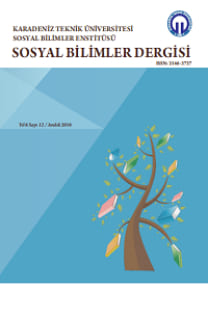Türkiye’de 1990 Sonrası Finansal Krizlerin Dış Borçlarla İlişkisinin Analizi
Çok sayıda gelişmekte olan ülkede ve Türkiye’de yaşanan finansal krizlerin en önemli nedenlerinden biri olarak aşırı boyutlara ulaşan dış borçlanma gösterilmektedir. Çünkü gelişmekte olan ülkelerde çok sık başvurulan bir finansman kaynağı olan dış borçlar, genellikle etkin-verimli kullanılmadığından, makroekonomik dengeleri olumsuz etkilemektedir. Bu nedenle birçok ülkede dış borçlanma finansal krizlerin temel nedeni olarak gösterilmekte ve bilimsel çalışmalara konu edilmektedir. Bu bağlamda Türkiye’deki 1994 ve 2001 krizlerinde de dış borçlanmanın önemli etkisi olduğu düşünülmüş ve dış borçlanmaya ilişkin bazı temel değişkenler dikkate alınarak ekonometrik testler uygulanmıştır. Sonuçlar, dış borç stoku/GSYH oranı ile ilgili krizler arasında pozitif bir ilişkinin varlığını göstermiştir.
Anahtar Kelimeler:
: Dış Borç, Finansal Kriz, Logit Regresyon
The Analysis of the Relationship Between External Debts and the Financial Crises in Turkey After 1990
One of the most important causes of financial crisis that experienced in many developing countries and Turkey is excessive amount of external debt. External borrowing is a source of funding that is often used in developing countries but since these sources generally not being used effectively it affects macro-economic balance negatively. Therefore, external debt is shown as the main causes of financial crises in many countries and it constitutes the subject of scientific studies. In this context, external borrowing is thought to have a significant impact on crisis of Turkey and logistic regression analysis is applied to test this effect by taking into account some key variables related to external debt. The results showed that the External Debt Stock/GDP ratio and Central Bank Reserves/Short-Term External Debt ratio have a significant effect on crises in Turkey.
Keywords:
External Debt, Financial Crisis, Logit Regression,
___
- Başarır, G. (1990). Çok Değişkenli Verilerde Ayrımsama Sorunu ve Lojistik Regresyon Analizi. Hacettepe Üniversitesi Fen Bilimleri Enstitüsü İstatistik Anabilim Dalı Doktora Tezi, Ankara.
- Bussiere, M., & Fratzscher, M. (2006). Towards a New Early Warning System of Financial Crises. Journal of International Money and Finance, 25(6), 953–973.
- Detragiache, E., & Spilimbergo, A. (2001). Crises and Liquidity: Evidence and Interpretation (IMF Working Paper No. 01/2), Washington DC.
- Diamond, D. W., & Dybvig, P. H. (1983). Bank Runs, Deposit Insurance, and Liquidity. Journal of Political Economy, 91(3), 401–419.
- Falcetti, E., & Tudela, M. (2006). Modelling Currency Crises in Emerging Markets: A Dynamic Probit Model with Unobserved Heterogeneity and Autocorrelated Errors. Oxford Bulletin of Economics and Statistics, 68(4), 445–471.
- Field, A. (2013). Discovering Statistics Using IBM SPSS Statistics. (M. Carmicheal, Ed.) (4th ed.), London: Sage Publications.
- Frankel, J. A., & Rose, A. K. (1996). Currency Crashes in Emerging Markets: An Empirical Treatment. Journal of International Economics, 41(3–4), 351–366.
- Granger, J. C. (1969). Investigating Causal Relations by Econometric Models and Cross-spectral Methods. Econometrica, 37(3), 424–438.
- Gujarati, D. N., & Porter, D. C. (2009). Basic Econometrics (5th ed.), New York: The McGraw-Hill.
- Oka, C. (2003). Anticipating Arrears to the IMF: Early Warning Systems (IMF Working Paper No. 03/18), Washington DC.
- Radelet, S., & Sachs, J. D. (1998). The Onset of the East Asian Financial Crisis (No. 6680). NBER Working Paper Series, Cambridge.
- Rodrik, D., & Velasco, A. (1999). Short-Term Capital Flows (No. 7364). NBER Working Paper Series, Cambridge.
- Ural, M. (2003). Finansal Krizler ve Türkiye. Dokuz Eylül Üniversitesi İktisadi ve İdari Bilimler Fakültesi Dergisi, 18(1), 11–28.
- Ünvan, Y. A. (2006). Koşullu Loji̇sti̇k Regresyon Çözümlemesi̇ ve Avrupa Bi̇rli̇ği̇ Veri̇si̇ Üzeri̇ne Bi̇r Uygulama. Hacettepe Üniversitesi Fen Bilimleri Enstitüsü İstatistik Anabilim Dalı Doktora Tezi, Ankara.
- ISSN: 2146-3727
- Yayın Aralığı: Yılda 2 Sayı
- Başlangıç: 2011
- Yayıncı: Karadeniz Teknik Üniversitesi Sosyal Bilimler Enstitüsü
Sayıdaki Diğer Makaleler
Çalışan Çocukların Sorunları Üzerine Bir Araştırma
TEZER ÖZLÜ’NÜN ESERLERİNDE YABANCILAŞMA BAĞLAMINDA GİTME TEMİ
Saliha AĞAÇ, Serap DENGİN SEVİNİR, Tuğba KİPER YILMAZ
TÜRKİYE’DEKİ MEVDUAT BANKALARININ FİNANSAL PERFORMANS DEĞERLENDİRMESİ: CAMELS YAKLAŞIMI
Mustafa EMİR, Gülay ÇİZGİCİ AKYÜZ
İktisat Dergilerine Göre Osmanlı Devleti’nin İktisadi Durumu (1857-1923)
Saliha AĞAÇ, Serap DENGİN SEVİNİR, Tuğba YILMAZ
6360 Sayılı Yasa’nın Yerel Yönetimler Ekonomisi Açısından Değerlendirilmesi
ÇALIŞAN ÇOCUKLARIN SORUNLARI ÜZERİNE BİR ARAŞTIRMA
Türkiye’de 1990 Sonrası Finansal Krizlerin Dış Borçlarla İlişkisinin Analizi
İKTİSAT DERGİLERİNE GÖRE OSMANLI DEVLETİ’NİN İKTİSADİ DURUMU (1857-1923)
